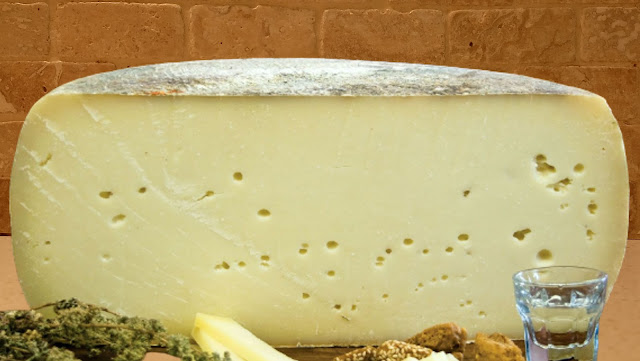In the picturesque landscapes of Greece, an extraordinary cheese known as graviera (γραβιέρα in Greek) has stood the test of time, captivating taste buds with its distinctive flavors and artisanal craftsmanship. Graviera is a hard yellow cheese made from sheep or a mix of cow, goat, and sheep milk. It resembles the Swiss Gruyère, which in Italian is called Griviera. Even though both kinds of cheeses have a similar ripening process, they have different tastes and textures. This is because, unlike graviera, the Swiss Gruyère is made only from cow milk. Graviera is the second most popular cheese in Greece right after the famous feta cheese.
PDO stands for "Protected Designation of Origin." It is a legal designation used in the European Union (EU) to protect the names of certain agricultural products, including foods and beverages, that are produced in specific geographical regions using traditional methods. The purpose of PDO is to preserve the authenticity and quality of these products and to prevent them from being imitated or produced elsewhere under the same name.
Having that in mind, we have the following PDO for Graviera Cheese:
- Graviera Kritis: This Graviera is produced in Crete from sheep's milk and its ripening time is at least five months.
- Graviera Agrafon: This graviera is made from whole, pasteurized sheep's milk to which up to 30% goat cheese can be added. The total ripening time lasts 3 months.
- Graviera Naxou: This Graviera is made from a minimum of 80% cow's milk and a maximum of 20% goat's milk, with the addition of traditional rennet.
Moreover, there are numerous other places in Greece that have their own version of this delicious cheese. Graviera Metsovou, Graviera Amfilochias, Graviera Kassou, and Graviera Tinou are other types of Graviera you should try. Each of these types of graviera has its own taste depending on the fauna of the region where it is produced and the time it takes to mature.
Culinary Versatility and Recipes
Graviera cheese's versatility in the kitchen is one of its greatest assets. Its robust flavors and firm texture lend themselves to a wide array of culinary applications. Here are some popular ways to savor the delights of graviera cheese:
- Cheese Platters: Graviera cheese shines as a centerpiece on cheese platters, offering a complex flavor profile that pairs well with fruits, nuts, and honey. Its versatility makes it a crowd-pleaser, suitable for various palates.
- Grating and Melting: Graviera's firm texture makes it an excellent choice for grating and melting. It can enrich pasta dishes, gratins, and traditional Greek recipes like moussaka. When melted, it forms a luscious, golden crust.
- Snacking and Meze: Sliced or cubed, Graviera cheese makes a delightful addition to a meze platter, providing a savory and satisfying option alongside olives, cured meats, and dips like tzatziki or hummus.
- Sandwiches and Wraps: Incorporate Graviera cheese into sandwiches or wraps for an elevated flavor experience. Its distinct taste adds depth to various fillings, from roasted vegetables to grilled meats.
- Accompaniments and Condiments: Graviera cheese can be enjoyed with a range of accompaniments and condiments. Pair it with crusty bread, drizzle it with extra virgin olive oil, or sprinkle it with aromatic herbs to enhance its flavor.
- Saganaki is a delicious Greek dish that features Graviera cheese as a star ingredient.
Graviera versus other Cheeses
- Graviera vs Kefalotyri (or kefalotiri): Graviera and Kefalotyri are both delicious Greek cheeses, but they have distinct characteristics. Graviera offers a nutty and slightly sweet flavor with a smooth texture, while Kefalotyri provides a sharp and salty taste with a crumbly texture which becomes more pronounced with aging. The cheese develops a rich and robust flavor that can be quite intense.
- Graviera vs Kefalograviera: Kefalograviera cheese has a buttery and creamy flavor with a slightly tangy note. It tends to be milder and less complex in flavor compared to Graviera due to the shorter aging period. Kefalograviera's taste is often described as smooth and balanced. Kefalograviera is aged for a shorter period, usually around three to six months. This shorter aging time gives it a softer and more elastic texture compared to Graviera. While Kefalograviera matures during this time, it retains a milder flavor compared to the more aged Graviera varieties.
